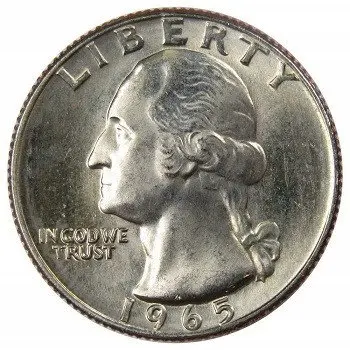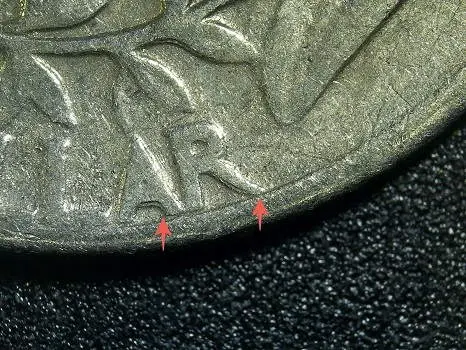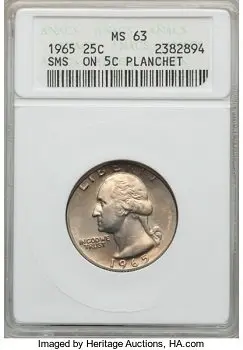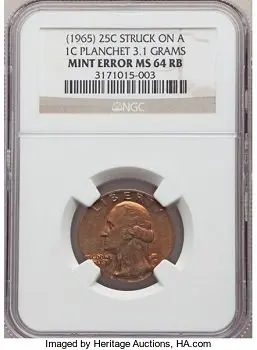Ed. note: This article is periodically updated to reflect the current price of most valuable coins.
In Coleccionistas de Monedas, we fight against the misinformation surrounding the world of coins on the Internet. For this reason, our articles are entirely written by people, not AI or other automated systems. Additionally, we link to all sources and references for coin prices, with the goal of providing you with real, updated, and reliable information.
How do we verify coin prices and values?
At Coleccionistas de Monedas, we are committed to providing accurate, trustworthy, and well-sourced numismatic information. We understand that articles about coin values can influence important financial decisions, which is why we apply a clear and rigorous methodology to estimate prices.
Sources used
- PCGS Price Guide: The official pricing guide from the Professional Coin Grading Service.
- NGC Price Guide: Updated valuation system from the Numismatic Guaranty Company.
- Heritage Auctions: Database of real auction sale prices.
- Red Book: Printed guidebook with historical pricing by grade.
- eBay Sold Listings: Only completed sales are considered, not asking prices.
Validation process
- Price review by condition grade using standard scales (MS, AU, XF, VF).
- Verification of varieties and errors through multiple data sources.
- Expert consultation when prices significantly deviate from the norm.
- Regular updates to reflect current market trends.
Important disclaimer
The values presented in this article are for reference purposes only. Final coin prices can vary significantly depending on authenticity, grade, and selling context. We strongly recommend having your coin certified by a professional service such as PCGS or NGC before selling or purchasing it as an investment.
This article looks back into the history of quarters and reveals their most valuable quarters from 1965 to today, and will show you which coin is worth the most, how much it’s actually worth, and a brief overview of its history.
Key Takeaways
- (2024 UPDATE) Minting errors of the 1965 Washington Quarter Dollar continue to be the most sought after and valuable on the market, maintaining the high prices of past years.
- In July 2023, a MS68 type specimen was auctioned by Heritage Auctions for a price of $11,400 (2023 July 20-23 Long Beach/Summer FUN U.S. Coins Signature Auction #1362).
- One of the most valuable error in the past year has been the 1964 silver coinage (90%), with the AU53 NGC selling for $7,800, surpassing the 2014 record.
- The next most revalued errors have been those minted on 1c, 5c and 10c coin blanks.
How much is a 1965 quarter worth in 2025
Is a 1965 quarter worth anything? Estimated Value of 1965 Washington Quarters in mint state is:
For lower grades, prices in 2025 range between $0,50 and $5 for MS63 (mint state uncirculated).
Therefore, it is worth reading the following article to learn about the errors or variants of the 1965 Washington quarter that are most valuable and in demand in today’s market, due to their scarcity or peculiarity.
JUMP TO SECTION
To be a good investment, the 1965 25 cents should have no sign of circulation. These signs of circulation can be bumps, scratches, heavy wear, and loss of original shine.
In these cases, the 1965’s quarters will be worth no more than its face value, 25 cents.
If you find an uncirculated copy, in perfect condition, then its value goes up exponentially and in this case, you have the choice of having it appraised or sending it to a grading company if you deduce its quality is high and it could be a good investment.
How to Identify an Original 1965 Quarter That’s Worth More Than $1
Checklist to determine its value:
- Learn to differentiate the different types and varieties of coins.
- Identify the state of preservation of your coin: Be honest and try to verify what is the actual grade your coin can be graded in. Doing this objectively will save you a lot of trouble. Mintstate rules!
- Know the key date varieties and relevant mint marks: Not all issue the same number of coins and some are more interesting than others to coin collectors.
Quarters with silver? What year quarters have silver?
Washington’s last quarter coinage in 90% silver took place in 1964. When did they stop making silver quarters in a silver planchet? From that date onwards its composition became a copper and nickel core.
In this post, we are going to focus on the first year of the Washington quarter’s cupronickel coinage that took place in 1965. In spite of the high number of pieces minted – more than 1.8 billion – it is not very common to find the Washington quarter without signs of having been circulated.
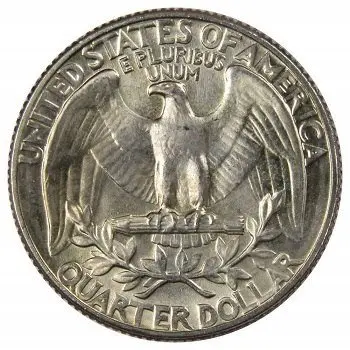
Since the material the coins are made of has no value – due to the absence of silver – you should look for the highest graduations and the best preservations for the Washington 25 cents whenever possible.
How to tell if a 1965 Quarter is Silver?
It’s possible that more 1965 silver error quarters are in existence. But how would you identify one? It’s simple. The easiest method is to weigh the coin on a calibrated gram scale. The standard clad quarters weigh 5.67 grams and the 90% 1965 silver quarters weigh 6.25 grams. You can also use the eye test. Silver quarters are shinier and they don’t have any copper or nickel layers showing on the edge of the coin.
Apparently, the 1965 Silver quarter is the same as those made of cupronickel, being easily confused.
How can we detect this error so sought-after and valued by collectors and investors?
There is only one way to prove it – by its weight. The 1965 Washington silver quarter weighs a little more than 6 grams, while the 1965 Washington cupronickel quarter, as we saw at the beginning of the article, weighs 5.67 grams.
This is a very difficult error to find since there are a lot of copies on the Internet. In fact, during 2020, we have not seen any pieces at auction in any international auction house.
1965 silver Washington quarters that appeared in auctions in years before 2020 have been auctioned for between $7,200 and $8,500 depending on their gradings.
Why are 1965 quarters valuable?
Are 1965 quarters worth anything A 1965 Washington quarter in a very high graduation like MS68 reached a value of $1,300 in 2020. So high is its scarcity at this graduation, PCGS has no specimens registered in this quality and NGC only 9 specimens. In case you want to know the prices of other years just click on Quarters worth money – Auction records.
In 2021 we have seen several quarter Washington 1965 SMS copies being slightly below the 1965 Washington quarter. In quality MS68+, it has reached $1,180 ($1,125 in MS68 CAMEO), from $31 to $63 we have found it in MS68 quality, from $60 to $132 for MS67 CAMEO, $36 for a MS67.
Characteristics of a 1965 quarter dollar
Here is a summary of the characteristics of the Washington quarter that you should know:
- Print run: 1,819,717,540
- Face value: 25 cents.
- Mint: Philadelphia (no mint mark)
- Designer-Trainer: John Flanagan
- Diameter: 24.3 mm
- Weight: 5.67 grams
- Composition: 75% copper and 25% nickel
- Reason: Commemoration of the bicentennial of the birth of the first President of the United States
- Period of circulation: 1932-1998
Due to the time and resources needed to produce the proof series, in 1964, these ceased. In that year, there was a shortage of coins: the increase in the price by most coin collectors increased the costs of the silver Kennedy half-dollars and Roosevelt dimes series. People chose to hoard them in large numbers to help them make a profit. Hence, hoarding was rampant. If we consider that the silver quarter dollar was worth 93.3 cents in the market, we can understand the banks’ difficulties in circulating silver coins. Continued coin production depleted the stock of silver (93.3 cents/ silver dollar coin at market prices). In 1965 U.S. Mint began to strike coins of superior quality without silver.
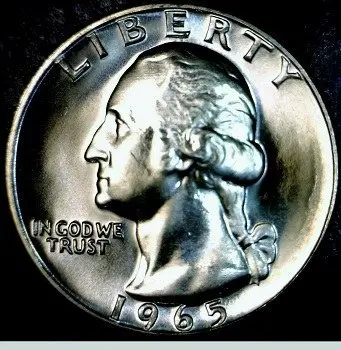
The 1965 quarter SMS (Special Mint Set) was produced at the San Francisco Mint, although the mint mark does not appear, with the same characteristics as the Philadelphia mint. A total of 2,360,000 SMS units were minted.
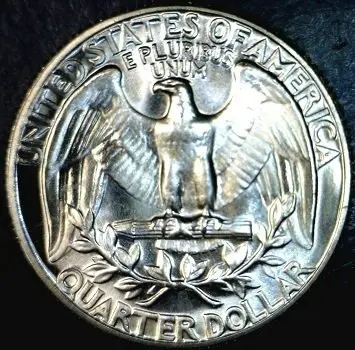
What rare 1965 quarter errors are worth money?
Are there any rare 1965 quarters? Keep on reading our list (include 1965 quarter errors).
|
List of valuable 1965 quarter with errors |
|
|
Type of error |
Fact-checked Estimated value |
|
Misprint error Off-center Coining 1965 Quarter |
$95-$312 |
|
1965 Error Silver Washington Quarter |
$7,050 |
|
DDO and DDR Error |
$2,300 |
|
1965 Quarter coined in planchets |
$1,440 |
|
Double Tail error |
$80,000 |
|
Error Double or Multi-Counterfeit |
$400 |
|
“Broad struck” and “Struck Through” errors |
$45 |
1. Misprint error Off-center Coining 1965 Quarter
A common error in these two currencies (1965 and 1965 SMS) that makes their price rise above the average, is known as off-center minting.

This error occurs in the manufacturing process when the die is not fixed in the correct position before the coinage, producing the printing of the wedges outside the established limits.
For this reason, the design of the obverse and reverse are displaced from the center of the coin. This offset can be from 1% to 99%.
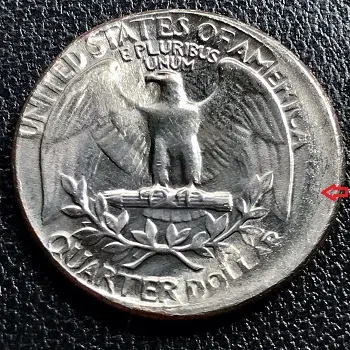
The demand and value of these pieces lie in the percentage of the off-center they present (the higher the off-center, the higher their value) and in the data that can be seen in the resulting coin.
In the following table, we reflect the prices of pieces that have appeared in auctions in 2020. You can see that they do not appear very often in international auctions although they are not so difficult to find on the Internet, although at a higher price.
1965 Quarter Off-center value chart
| 10% off | 1965 | 1965 SMS |
|---|---|---|
| MS65 | $85 | $126 |
| MS64 | ||
| MS63 | $89 | $312 |
| MS62 | $51 |
In case of 35% off center the reference price for a MS64 grade is $95.
2. 1965 Error Silver Washington Quarter
As we said, the 90% 1965 silver quarters were discontinued in 1964. However, in 1965, silver Washington quarters dated 1964 and cupronickel quarters dated 1965 were minted simultaneously.
At least one 1965 90% silver quarter is known to exist and in 2014 it sold for $7,050 at an auction.
That year, 1965, was minted in large quantities and presumably, this error was caused by using a certain consignment of silver planchets dated 1964 for the year 1965.
3. DDO and DDR Error: Double Coin on the Front (DDO) or on the Back (DDR)
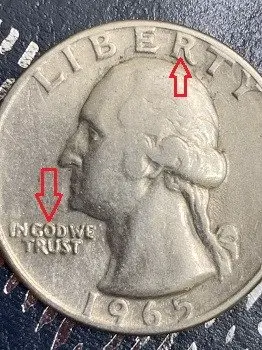
In the third place of most important 1965 quarter error is another type of 1965 Washington quarter originated by a mistake in the minting of the obverse. It is not easy to detect it with the naked eye either, which is why you may want to pay attention to the phrase “IN GOD WE TRUST” and the word “LIBERTY” on the front. These are the areas where this double minting is best appreciated. It is also common to see these double mints on the nose and mouth of Washington on some 1965 quarters.
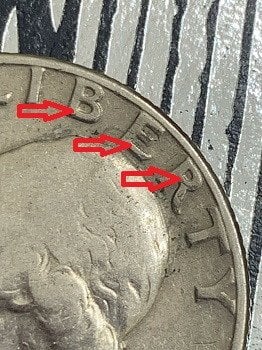
The valuation of a 1965 25-cents with double coinage on the front ranges from $360 to $2,300.
There is another variant similar to the previous one, but in this case the double minting is produced on the reverse side and is better appreciated in some letters of the “QUARTER DOLLAR” value.
Reviewing the market for these two variants, the error on the back is less valuable than the double coinage on the front, as it is not such a sought-after piece by collectors. Its price is anywhere between $25 and $175.
4. Error 1965 Quarter coined in planchets of different modules
The year 1965 was also a transition year for other American currency modules such as the ‘silver dimes’. For this reason large quantities were minted, and different coin planchets were used during 1965 for different modules and dates.
Thus, there are pieces of 25 cent Washington coins from 1965 that were minted on dimes (10 cents), 5 cents or 1 cent coin planchets. Here are some examples:
They are easy to detect visually since part of the coin is somewhat trimmed as it cannot accommodate the smaller planchet dimensions of a 25 cent, and even for the value of 1 cent which is a different material composition.
They are also detectable with a coin-weighing scale, as in the case of the 1965 silver-minted quarter. For example, this is because the 5 cents planchet weighs just 5 grams and the 25 cents coin weighs 5.67 grams.
This year, 2020, a 1965 quarter coin minted on a 1 cent MS64 grade planchet has been seen in auctions, reaching a value of $552. Also, a 10 cent silver dime coin on MS64 grade planchet, whose price was $1,440.
5. Error Double Tail 1965 Quarter
Only 3 copies of this rare and unexplained error are known, consisting of the same minting of the reverse side on both sides of the coin. Two of those three copies were sold long ago for $80,000 and $41,000.
Since the back does not show the date, it is not known exactly if the error belongs to this year, but numismatic experts consider that the date of minting was between 1965 and 1967.
Do you want to know more about 1967 quarters? Click here to find out all about the value of the 1967 quarter.
As a warning, we will say that there are many counterfeits of this error, created by cutting Washington quarter coins in half and then gluing the two backs together. To avoid being cheated, we have to look at the edge of the coin and its exact weight.
6. Error Double or Multi-Counterfeit 1965 Quarter
The error comes from the fact that the coin could not be expelled after the printing of the obverse and reverse, and received another minting blow. Its price is over $400.
It is also normal in this error for a certain rotation of the obverse and reverse of the same coin. Since they cannot be expelled, they frequently remain turned before the second or following mintings.
This makes it difficult to check their authenticity in photos, and a visual check of the piece with this error is absolutely necessary.
7. Error “Broad Struck” and “Struck Through” 1965 Washington Quarter
To conclude, here are some examples of other types of errors or known variants of these 1965 Washington 25-cents called “Broad struck” and “Struck Through“.
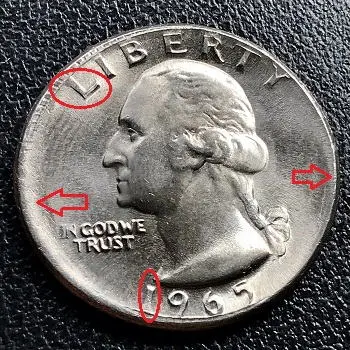
In one of them the ring that holds the coin in the coinage did not work properly and the coin is minted as if it were expanded, so its legends look longer and flatter than normal.
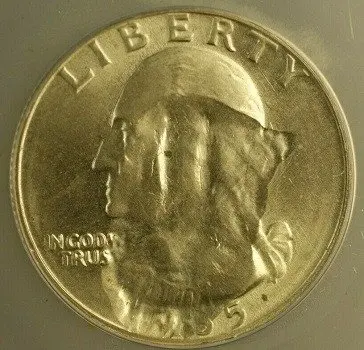
In the “Struck Through” variant, some kind of impurity (staple, clip, etc…) got between the die and some of the wedges at the moment of the coinage, leaving an imperfection in the coin.
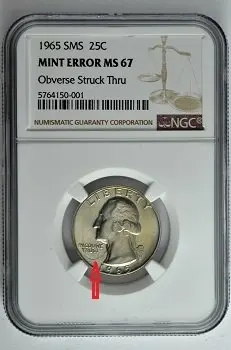
They are not as sought after as the variants we have seen previously in the article, but if you come across any of them, you will multiply the value of your quarter.
What makes a 1965 quarter rare?
In general, a 1965 quarter is not considered rare. It’s one of the most common coins from the 1960s. However, some specific factors can make a 1965 quarter more valuable or sought-after by collectors. For example:
- Mint Mark: Most 1965 quarters were struck at the Philadelphia Mint, which did not use a mint mark. However, some were also produced at the Denver and San Francisco Mints, which can be identified by a “D” or an “S” mint mark. Quarters from the San Francisco Mint are considered more valuable because they had a lower mintage.
- Condition: As with any coin, the state of a 1965 quarter can affect its value. Coins that are in a better grade, with less wear and fewer scratches, are generally more valuable than those that are heavily circulated.
- Errors: Like any coin, 1965 quarters can have errors that occurred during the minting process. For example, some may have double strikes, where the coin was struck twice in the same location, or have other striking errors. These types of specimens can be quite valuable to collectors.
How much is a 1965 quarter worth today?
The value of a 1965 quarter can vary depending on its condition, rarity, and other factors. In general, though, a 1965 quarter is not considered a valuable coin.
If it is a standard 1965 quarter from the Philadelphia Mint (with no mint mark), in circulated condition, it is likely only worth its face value of 25 cents.
However, if it is in uncirculated or near-uncirculated condition, it may be worth slightly more to a collector. For example, a 1965 quarter in uncirculated condition might sell for around $1 to $2, depending on the specific coin’s conservation and other factors. If the 1965 quarter is a rare or unusual variety, it could be worth more. For example, a 1965 quarter with a “D” (Denver) or “S” (San Francisco) mint mark in uncirculated condition could be worth several dollars to a collector.
Is a 1965 quarter worth $7,000?
There are some extremely rare and valuable quarters from 1965 and mint marks that could be worth thousands of dollars, For example the 1965 Error Silver Washington Quarter, with an estimated value of $7,050. Above you can find more information about this type of 1965 quarter error.
How much is a 1965 quarter worth with no mint mark?
A 1965 quarter with no mint mark is worth its face value of 25 cents if it is in circulated condition. If the coin is in uncirculated or near-uncirculated condition, it may be worth slightly more to a collector. For example, an uncirculated 1965 quarter without a mint mark might sell for around $1 to $2, depending on the specific coin’s condition and other factors.
Conclusions about 1965 Quarter value
In light of this article, our recommendation is to establish a series of routines when reviewing every 1965 Washington quarter that falls into your hands, in case it has more value than you first thought:
- Look for 1965 quarters in high quality.
- Look carefully at each coin, even if it is in circulation, on the obverse (In God We Trust and Liberty) and on the reverse (Quarter Dollar) in case there is any double minting.
- Be aware of any imperfections or mismatches on the rim and the edge of the coin.
- Review both sides of the coin for any scratches or imperfections in the field.
Here’s a quick recap of 1965 Quarters worth money:
| Fact-checked 1965 Quarter Value | |
|---|---|
| 1965 SMS | Updated Value (with Source) |
| MS68 | $5,250 |
| SP67 | $5,000 |
| MS67 | $375 |
| MS65 | $10 |
| MS64 | $7,50 |
References and sources
Coleccionistas de Monedas writers use primary sources to support their work. Primary sources include technical reports, government reports, original articles, and interviews with experts in the coin and investment sector. We also reference original research from other reputable editors when appropriate. You can learn more about the standards we follow to produce accurate and unbiased content in our editorial policy.
- PCGS: Washington Quarter (1932-1998).
- Heritage Auctions
- NGC
- PCGS Coin Facts
- NGC Price Guide
- U.S. Mint
- The Official Red book 2025, “A Guide Book of United States Coins, https://g.co/kgs/8TcE3yq”

